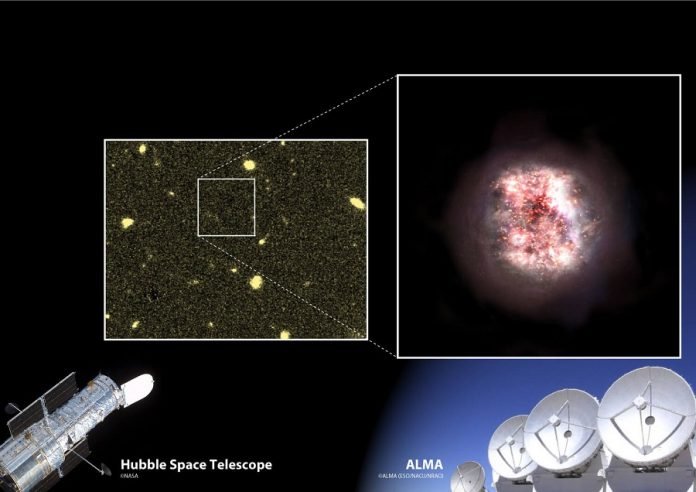
Astronomers at the University of Copenhagen’s Cosmic Dawn Center have discovered two previously invisible galaxies 29 billion light-years away.
Their discovery suggests that up to one in five such distant galaxies remain hidden from our telescopes, camouflaged by cosmic dust.
The new knowledge changes perceptions of our universe’s evolution since the Big Bang.
Researchers have just discovered two previously invisible galaxies 29 billion light-years away from Earth.
The two galaxies have been invisible to the optical lens of the Hubble Space Telescope, hidden behind a thick layer of cosmic dust that surrounds them.
But with the help of the giant ALMA radio telescopes (Atacama Large Milimeter Array) in Chile’s Atacama Desert, which can capture radio waves emitted from the coldest, darkest depths of the universe, the two invisible galaxies suddenly appeared.
“We were looking at a sample of very distant galaxies, which we already knew existed from the Hubble Space Telescope.
And then we noticed that two of them had a neighbor that we didn’t expect to be there at all.
As both of these neighboring galaxies are surrounded by dust, some of their light is blocked, making them invisible to Hubble,” explains Associate Professor Pascal Oesch of the Cosmic Dawn Center at the Niels Bohr Institute.
The study has just been published in the scientific journal, Nature.
10-20 percent of the universe’s galaxies are missing
The new discovery suggests that the very early universe contains many more galaxies than previously assumed. They simply lie hidden behind dust consisting of small particles from stars. However, they can now be detected thanks to the highly sensitive ALMA telescope and the method used by the researchers.
Facts about the research:
- The two hidden galaxies are so far called REBELS-12-2 and REBELS-29-2.
- The light from the two invisible galaxies has travelled about 13 billion years to reach us.
- The galaxies are now located 29 billion light years away due the universe’s expansion.
- Researchers used the ALMA telescope, which is based on radio signals.
- The ALMA Telescope combines the light of all its 66 antennae to create a high resolution image and spectra of the sky.
By comparing these new galaxies with previously known sources in the very early universe, approximately 13 billion years ago, the researchers estimate that between 10 and 20 percent of such early galaxies may still remain hidden behind curtains of cosmic dust.
“Our discovery demonstrates that up to one in five of the earliest galaxies may have been missing from our map of the heavens. Before we can start to understand when and how galaxies formed in the Universe, we first need a proper accounting,” says Pascal Oesch.
New super telescope will find the missing galaxies
To help with that task, NASA, ESA and the Canadian Space Agency have built a new super telescope, the James Webb Space Telescope, which is expected to be launched into orbit on the 18th of December 2021.
With its strength and improved technology, the telescope will gaze even deeper into the universe and contribute new knowledge about its origins.
This will, among many other things, help Cosmic Dawn researchers at the Niels Bohr Institute see through the cosmic dust.
“The next step is to identify the galaxies we overlooked, because there are far more than we thought. That’s where the James Webb Telescope will be a huge step forward.
It will be much more sensitive than Hubble and able to investigate longer wavelengths, which ought to allow us to see these hidden galaxies with ease,” states Pascal Oesch, adding:
“We are trying to put the big puzzle about the universe’s formation together and answer the most basic question: ‘Where does it all come from?’
The invisible galaxies that we’ve discovered in the early universe are some of the first building blocks of the mature galaxies we see around us in the Universe today. So that’s where it all began.”



